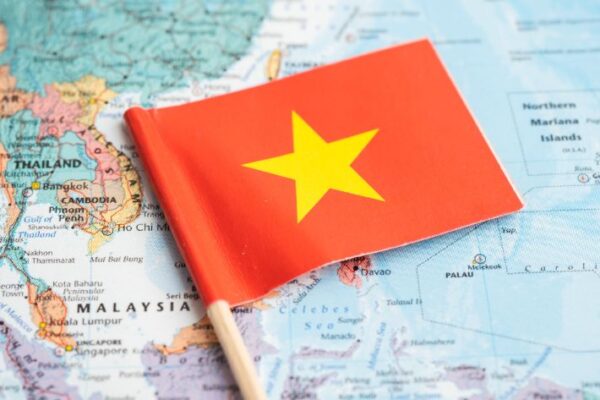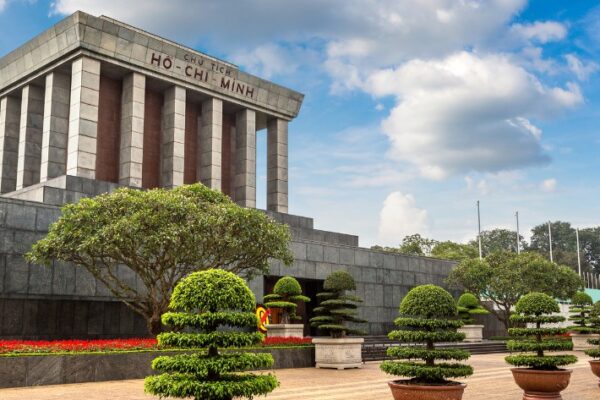Cu Chi Tunnels – A Complete Guide To Vietnam’s Underground History
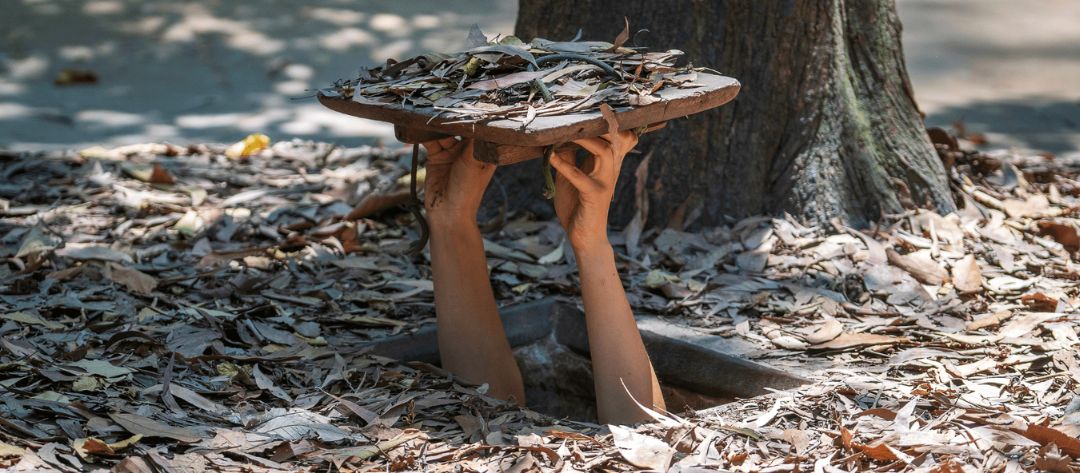
Beneath the lively hum of Ho Chi Minh City lies a silent storyteller of Vietnam’s resilient past: the Cu Chi Tunnels. More than just an intricate web of passageways, these tunnels stand as a testament to the nation’s tenacity and strategic genius during challenging times. A crucial cornerstone in the tale of Vietnam’s history, every nook and cranny here narrates tales of bravery, innovation, and endurance.
Eager to delve deep into this hidden world and discover its significance? Lace up for a journey of discovery and let the Cu Chi Tunnels unveil their secrets.
The Remarkable History of Cu Chi Tunnels
The Cu Chi Tunnels, while today a point of fascination for many, began as a strategic necessity during a tumultuous period in Vietnam’s history.
Origin and Purpose
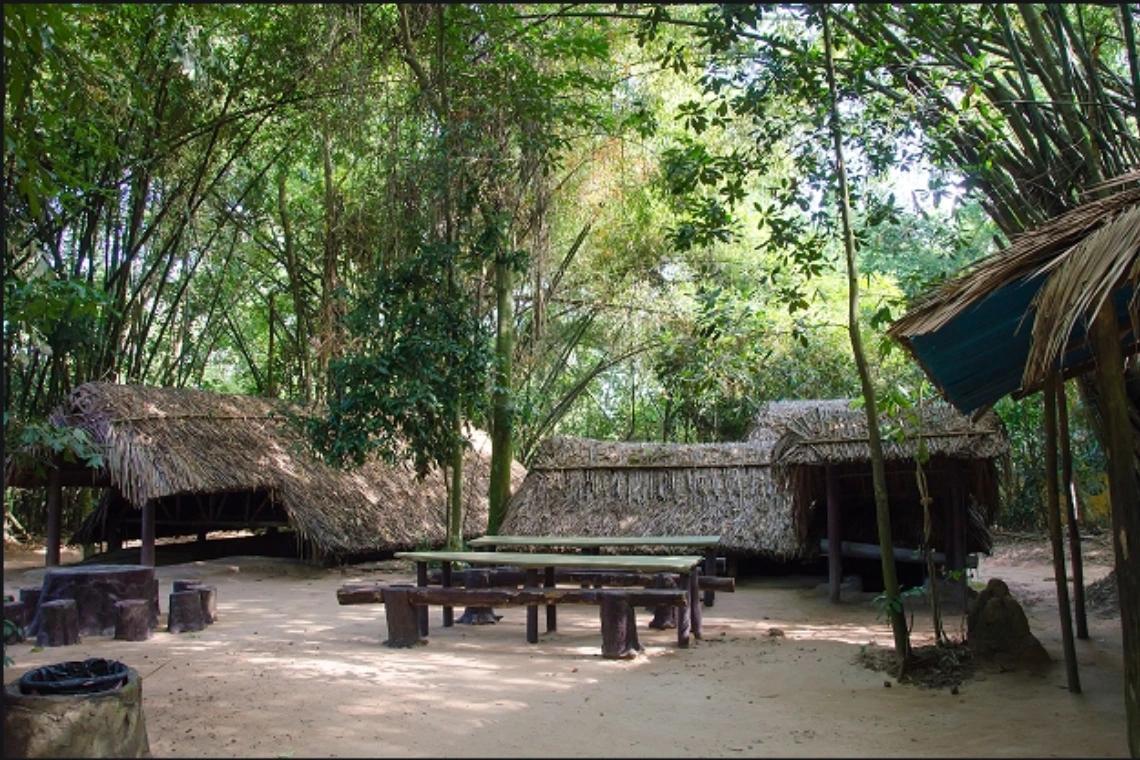
A Scene Of Cu Chi Tunnels
The roots of the Cu Chi Tunnels trace back to the late 1940s during the anti-French resistance. However, their real significance emerged during the Vietnam War in the 1960s. Designed by the Viet Cong as a hiding spot from the prying eyes of enemy forces, these tunnels played a pivotal role in guerrilla warfare, allowing for surprise attacks and quick retreats.
Role in Guerrilla Warfare
The Viet Cong, the communist fighters from the North, used the tunnels as an effective strategy against the better-equipped American and South Vietnamese forces. The tunnels, hundreds of meters which were dug by hand, served as hiding spots and as communication and supply routes, hospitals, food and weapon caches, and living quarters. This subterranean network was a lifeline, facilitating mobility and surprise, giving the Viet Cong a strategic edge.
Strategies Used by the Viet Cong
The tunnels were a masterstroke of military strategy. They were built on multiple levels and sections to confuse enemies and protect inhabitants from bomb blasts and chemical attacks. Hidden entrances, often camouflaged as termite mounds or hidden beneath kitchen shelters, ensured discreet access. Booby traps were strategically placed to deter any intruders, making the tunnels a perilous place for anyone unfamiliar with their complicated designs.
The Cu Chi Tunnels, thus, weren’t just underground passageways; they were a symbol of the Viet Cong’s resilience, intelligence, and adaptability, playing a pivotal role in shaping the outcome of the Vietnam War.
An Architectural Marvel That Stood Strong Through Time
The Cu Chi Tunnels, stretching all the way to the Cambodian frontier, once boasted an impressive length of nearly 250 kilometers. Out of this, 120 kilometers have been meticulously preserved and are now open to the public. This astonishingly intricate architecture, especially built on a base of clay soil mixed with laterite, stands as a testament to the brilliance and resilience of its builders.
Multi-level Structure
The tunnels were not merely surface pathways but spanned multiple depths. The underground system comprised three main levels connected through a central axis, extending all the way to the Saigon River.
- The first level, situated 3 meters beneath the ground, was robust enough to withstand bullets, tanks, armored vehicles, and even chemical warfare.
- The second level, deeper at 6 meters, was designed to resist heavy bombings.
- The deepest third level plunged over 12 meters underground.
Escape hatches between these levels acted as safeguards against toxic gases, while concealed vents ensured ventilation and a supply of fresh air from the surface. Communication passages, typically measuring between 0.8 to 1.2 meters, had roofs at least 1.5 meters thick, ensuring safety and secrecy.
Booby Traps and Secret Entrances
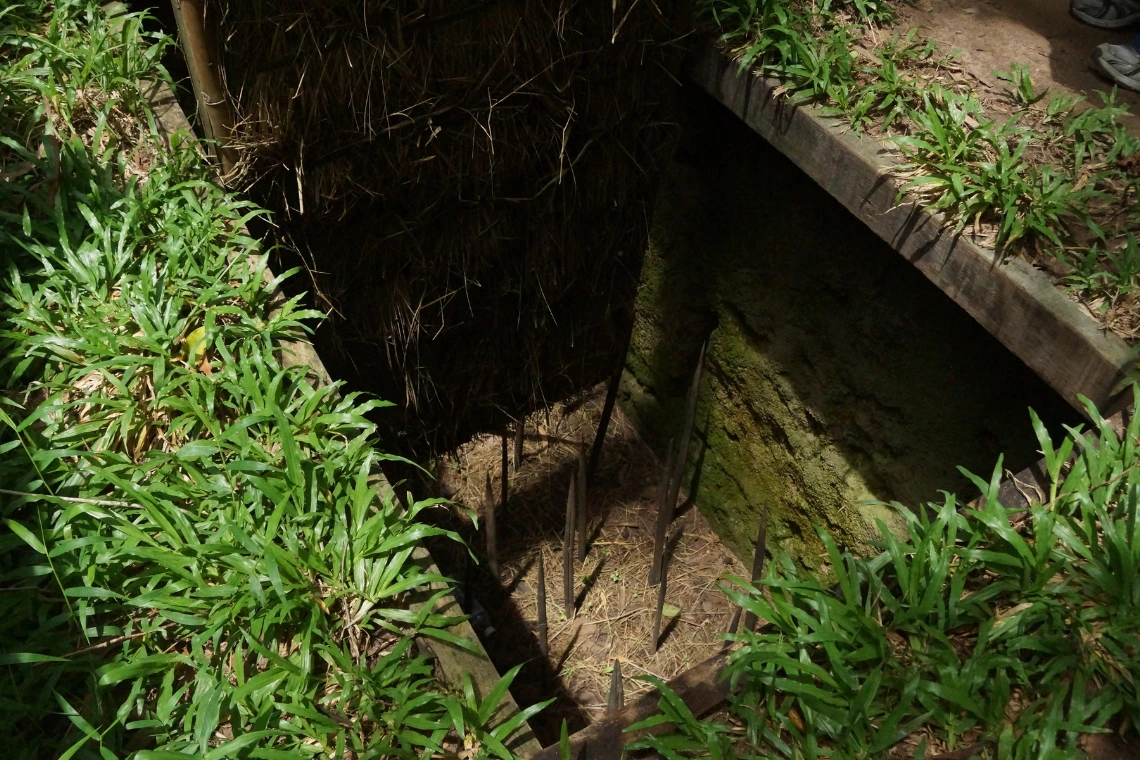
Spike Trap In Cu Chi Tunnels
Above ground, the area was riddled with hundreds of crafty booby traps and fake bunkers designed to deceive and harm unsuspecting enemies. Tunnel entrances were so discreet and narrow that they seemed tailor-made for the Vietnamese, with wooden manhole covers seamlessly blending into the environment, camouflaged by natural foliage.
Construction
One of the most awe-inspiring aspects of the Cu Chi Tunnels is the sheer manual labor that went into their creation. Vietnamese soldiers hand-dug this vast underground network using only basic tools. Often likened to an underground city, the tunnel system housed facilities like kitchens, hospitals, schools, theaters, armories, chambers, and command centers capable of accommodating thousands of soldiers and civilians.
Life Inside the Tunnels – Hardship vs. Resilience
Life in the Cu Chi Tunnels was far from comfortable. Inhabitants, often termed “human moles,” faced extremely challenging conditions.
Living Conditions
The air inside the tunnels was often stifling, becoming so hot by afternoons that inhabitants would lie flat on the ground to breathe. The absolute darkness was so intense that some, after prolonged stays underground, temporarily lost their sight upon emerging into daylight.
Prolonged stays, sometimes stretching into weeks, meant cohabiting with bats, rats, snakes, scorpions, centipedes, and fire ants. Some of these creatures, like scorpions and vipers, were ingeniously used as traps for unsuspecting intruders.
Facilities and Daily Life
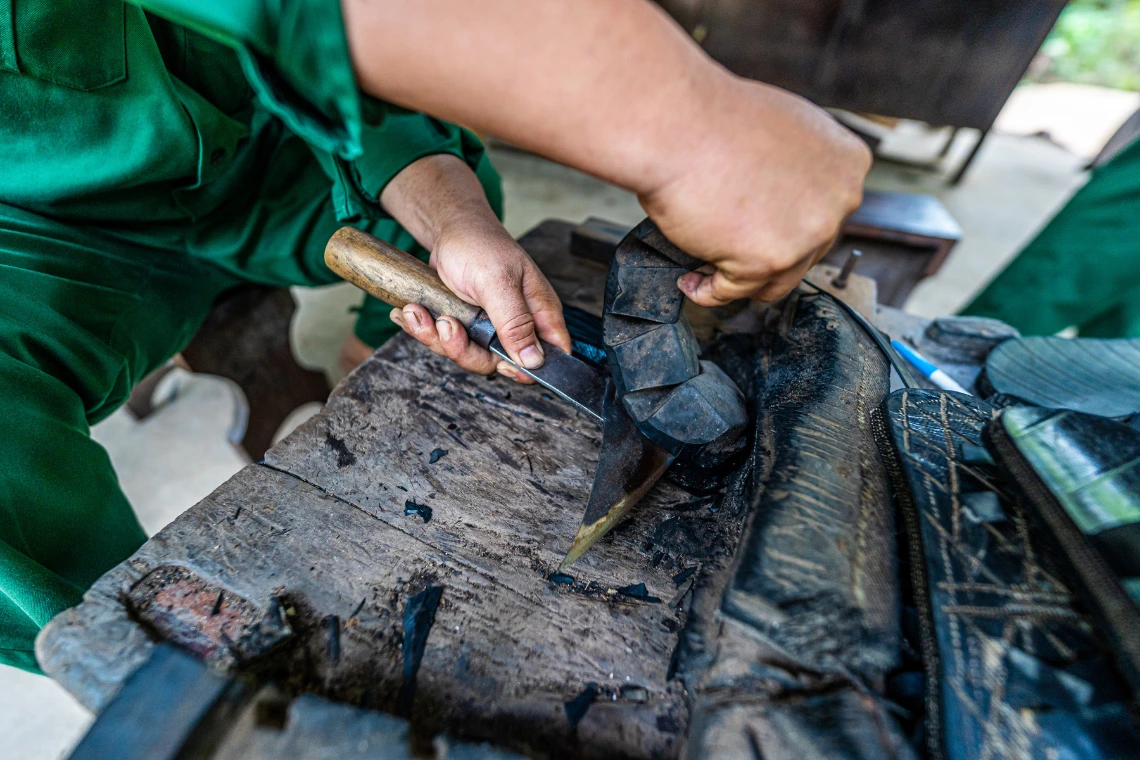
A Demonstration Of How People In Cu Chi Created Items In The Past
Despite these hardships, the tunnels were well-organized. They had latrines, wells, meeting rooms, and dormitories. Rudimentary hospitals were carved out, where operations were conducted using instruments made from bomb shards. Blood transfusions were performed using bicycle pumps and rubber hoses. Medical supplies, often procured by bribing ARVN soldiers in Saigon, included herbs, acupuncture, and even honey for its antiseptic properties.
Kitchens, with limited resources due to destroyed crops, primarily served tapioca, leaves, and roots. However, innovation persisted, with bomb fragments being sold in Saigon to procure food. Morale boosters included performing troupes that traveled through the tunnels, offering entertainment and uplifting spirits.
Life in the Cu Chi Tunnels stands as a testament to human adaptability, innovation, and the unyielding spirit to survive and thrive in the most testing circumstances.
>> Read More: Explore These 14 Vietnam Historical Landmarks To Learn About The Country’s Intriguing Past
The Cu Chi Tunnels Today
How to Get There?
Location
- Address: TL15, Phu Hiep, Cu Chi District, Ho Chi Minh City.
- Opening hours: 8 AM – 5 PM, daily.
- Entrance fees (as of 2022): Ben Duoc: 110,000 VND/person; Ben Dinh: 90,000 VND/person
Getting to Cu Chi Tunnels
- By Taxi: The quickest but pricier option, reaching the tunnels in about 1.5 hours.
- By Bus: The most economical route, though it may take approximately 2.5 hours and costs around 25,000 VND. Start with bus No. 13 from 23-9 Park/Ben Thanh Bus Station or No. 94 from Cho Lon/12 Xuan Dieu to Cu Chi Bus Station. From there, hop onto bus No. 79 for Ben Duoc Tunnel or bus No. 63 for Ben Dinh Tunnel.
- Private Motorbike/Car: Rent a vehicle in Ho Chi Minh City and head northwest on National Road 15. Ensure you have GPS and check weather conditions, as the route might be tricky for newcomers.
- By Boat/Canoe: For a unique experience, embark on a speedboat journey from Tan Cang pier along the Saigon River, reaching Cu Chi in about 75 minutes.
Transformation into a War Memorial and Museum
Over the years, the Cu Chi Tunnels have transitioned from their original military purpose to serve as a poignant war memorial and museum.
The meticulous preservation of the tunnels, accompanied by curated exhibits, ensures that visitors from all over the world can understand and appreciate the challenges faced by those who lived and fought here.
Nevertheless, the upkeep of the Cu Chi Tunnels is not merely for tourism; it is a conscious effort to preserve a significant chapter of Vietnamese history. Continuous conservation efforts ensure that the tunnels, despite being decades old, remain accessible to the public.
They stand as a living testament to the Vietnamese people’s sacrifices, strategies, and tenacity during a tumultuous period in their history. By maintaining and promoting the tunnels, Vietnam emphasizes the importance of remembering history, learning from past experiences, and ensuring that such stories of courage and sacrifice are passed down to future generations.
Exploring The Maze Of Cu Chi Tunnels
Experiencing the Cu Chi Tunnel Complex
- Ben Dinh Tunnels
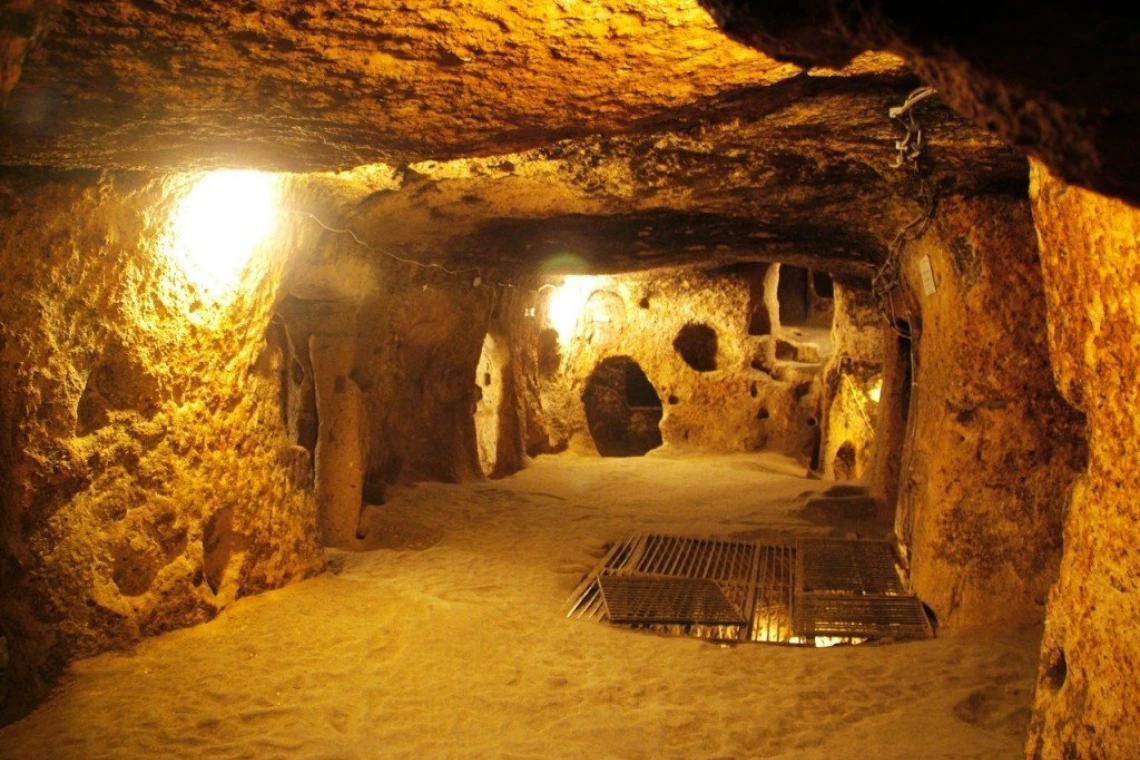
Underground Maze Inside Cu Chi Tunnels (Source: Collected)
Adjacent to the Saigon River, this section, operational between 1968 and 1975, has been expanded for tourists. It begins with a hut showcasing regional maps, tunnel layouts, and documentaries. As you proceed, local guides demonstrate the hidden booby traps and concealed pits. They will also share captivating stories of those who once called this place home.
- Ben Duoc Tunnels
Covering a larger area than Ben Dinh, this site offers a more immersive experience. Ben Duoc Tunnels (100 hectares) is 5 times bigger than the Ben Dinh Tunnels (17 hectares), allowing visitors to navigate through the extended and illuminated tunnels. The old tunnels have been enlarged and renovated through cementation and lighting to make the journey safer and less terrifying than it was in the past.
While it offers a genuine feel of the underground city, caution is advised for those with health concerns.
Visit the Military Liberation Zone’s Reenactment Areas
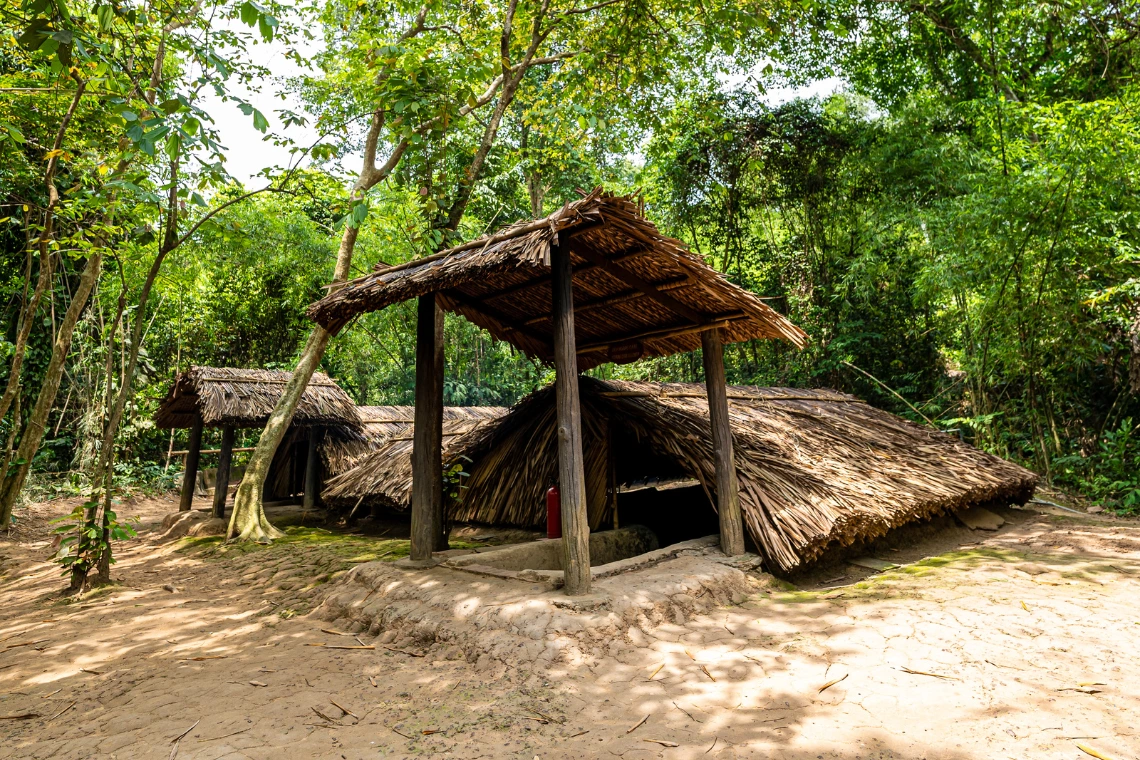
Guerilla Camp At Cu Chi Tunnels
These sections vividly depict the intense wartime period from 1961 to 1972 in South Vietnam, transporting visitors back in time. They portray the lives of the Vietnamese guerrilla soldiers and the devastation caused by chemicals, artillery, and bombings.
Try Shooting Guns and Paintball Guns
For those seeking adrenaline, both Ben Dinh and Ben Duoc provide shooting ranges where participants can handle wartime weapons. Paintballing, set in a natural forest backdrop, offers a simulation of wartime strategies and camaraderie.
Tips For Visiting Cu Chi Tunnels
Exploring the Cu Chi Tunnels is a memorable experience, but to ensure a smooth and respectful visit, here are some essential tips to keep in mind:
What to Wear and Bring
- Dress Appropriately: Given the presence of mosquitoes in the area, wearing long sleeves and trousers is advisable. This not only offers protection against insect bites but is also respectful when visiting such a significant historical site.
- Pack Essentials: While the tunnels offer a unique exploration experience, it’s crucial to come prepared. Bring insect repellent to ward off mosquitoes. If you plan to spend a significant amount of time, consider packing some food and drinks beforehand.
- Travel Light: The tunnels can be narrow and challenging to navigate with many belongings. If you have excess luggage, it’s best to leave it outside or in a designated area.
Respectful Behavior Reminders
- Follow Instructions: The tunnels can be intricate, so it’s easy to lose your way. Always listen to and follow the staff’s guidance to ensure a safe exploration.
- Mindful of the Significance: The Cu Chi Tunnels hold immense historical importance. Always be respectful during your visit. Refrain from loud or disruptive behavior, and remember the sacrifices of those who lived and fought here.
- Additional Costs: While the entrance fee provides access to the tunnels, be aware that some games or activities might incur additional charges. During holidays, entrance fees might be higher, but often, this comes with the perk of extra activities for visitors.
Embarking on a journey through the Cu Chi Tunnels is not just about witnessing history but also honoring the memories of those who endured hardships within these walls. Keeping these tips in mind will ensure a meaningful and respectful visit.
Step into Vietnam’s Underground History at the Cu Chi Tunnels
Visiting the Cu Chi Tunnels is more than just a tour – it’s an unforgettable journey into the heart of Vietnam’s resilient past. As you navigate this intricate underground world, you’ll uncover the stories of bravery, survival, and the incredible ingenuity that shaped the course of history. From the cleverly hidden traps to the vast network of tunnels, each step offers a glimpse into the resourcefulness of the people who lived through such challenging times. Whether you’re a history buff or someone looking to understand the spirit of Vietnam, the Cu Chi Tunnels are sure to leave a lasting impression on your soul.
Ready to experience the Cu Chi Tunnels and explore the rich history of Vietnam in a way that’s tailored just for you? Let Asia Pioneer Travel craft the perfect adventure that takes you beyond the ordinary. Our expert team will guide you to not just the iconic spots but also the hidden treasures that make Vietnam truly unique.
Reach out to Asia Pioneer Travel today, and let’s make your Vietnam journey an unforgettable one!
